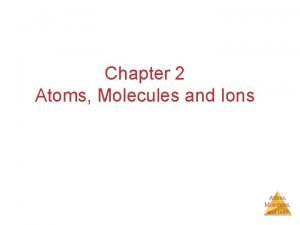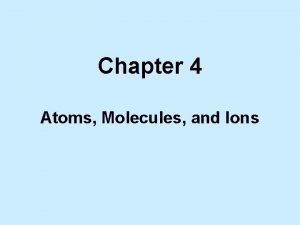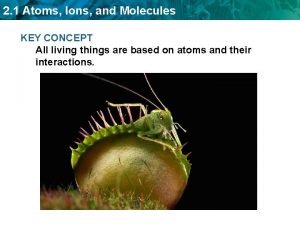2 1 Atoms Ions and Molecules KEY CONCEPT






- Slides: 6

2. 1 Atoms, Ions, and Molecules KEY CONCEPT All living things are based on atoms and their interactions.

2. 1 Atoms, Ions, and Molecules • Living things consist of atoms of different elements. • An atom is the smallest basic unit of matter. Millions of atoms would fit into a space the size of a period at the end of this sentence. • An element is one type of atom. H • The human body has 6 major elements: C, H, O, N, Ca, P and 22 other elements in trace amounts: K, Na, Cl, Mg, S, B, Cr, Co, F, I, Fe etc… Hydrogen atom (H) Oxygen atom (O) O

2. 1 Atoms, Ions, and Molecules • An atom has a nucleus and electrons. – The nucleus has protons and neutrons. – Electrons are in energy levels outside nucleus. Oxygen atom (O) Nucleus: 8 protons (+) 8 neutrons outermost energy level: 6 electrons (-) inner energy level: 2 electrons (-)

2. 1 Atoms, Ions, and Molecules • A compound is made of atoms of different elements bonded together. – water (H 2 O) _ O H +

2. 1 Atoms, Ions, and Molecules • A compound is made of atoms of different elements bonded together. – water (H 2 O) – carbon dioxide (CO 2) Contrast: How are elements different from compounds?

2. 1 Atoms, Ions, and Molecules • Atoms share pairs of electrons in covalent bonds. • A covalent bond forms when atoms share a pair of electrons. These form when a non-metal is bonded to a non-metal. – multiple covalent bonds Oxygen atom (O) Carbon atom (C) Carbon dioxide (CO 2 ) Oxygen atom (O)










